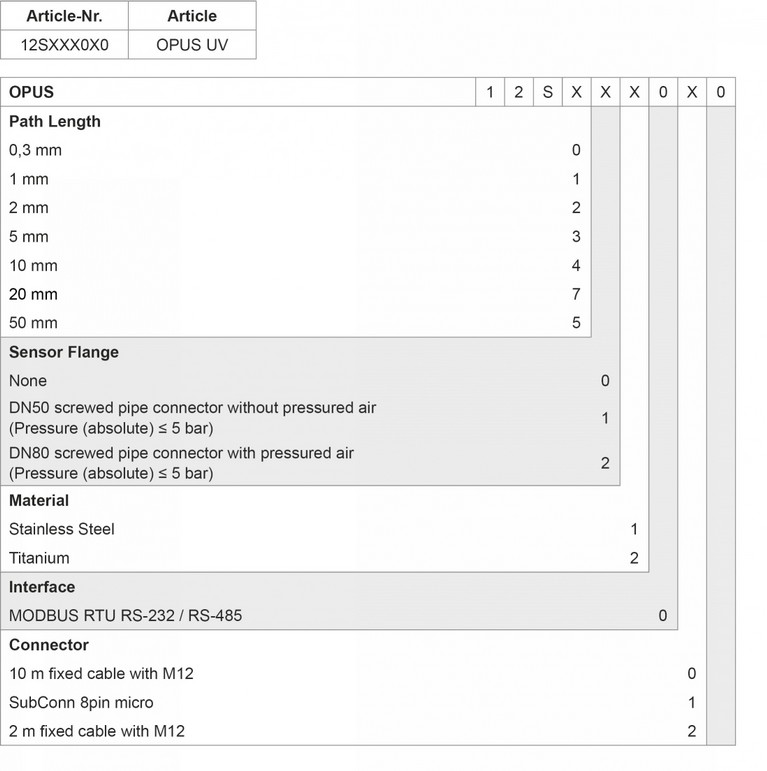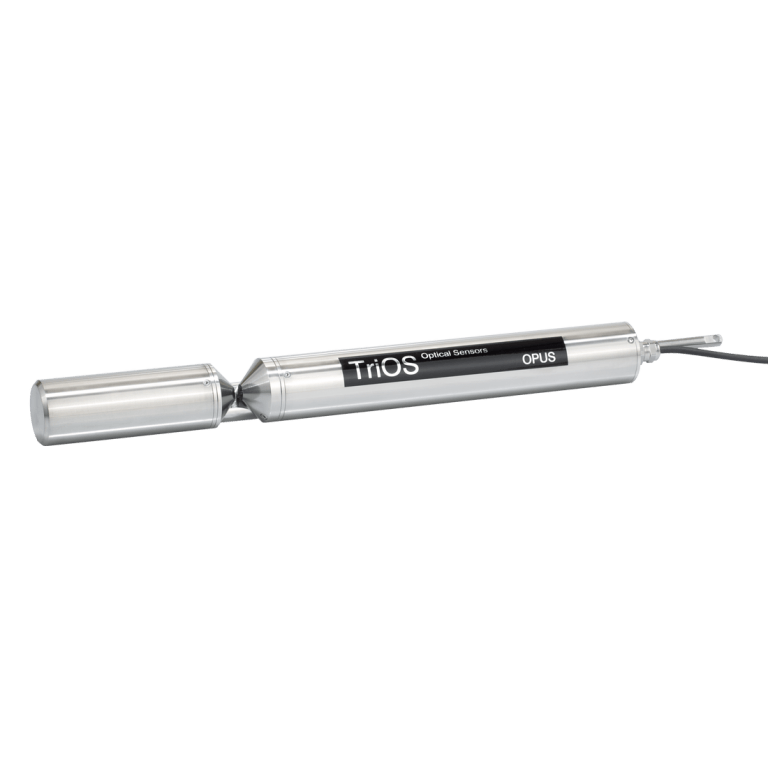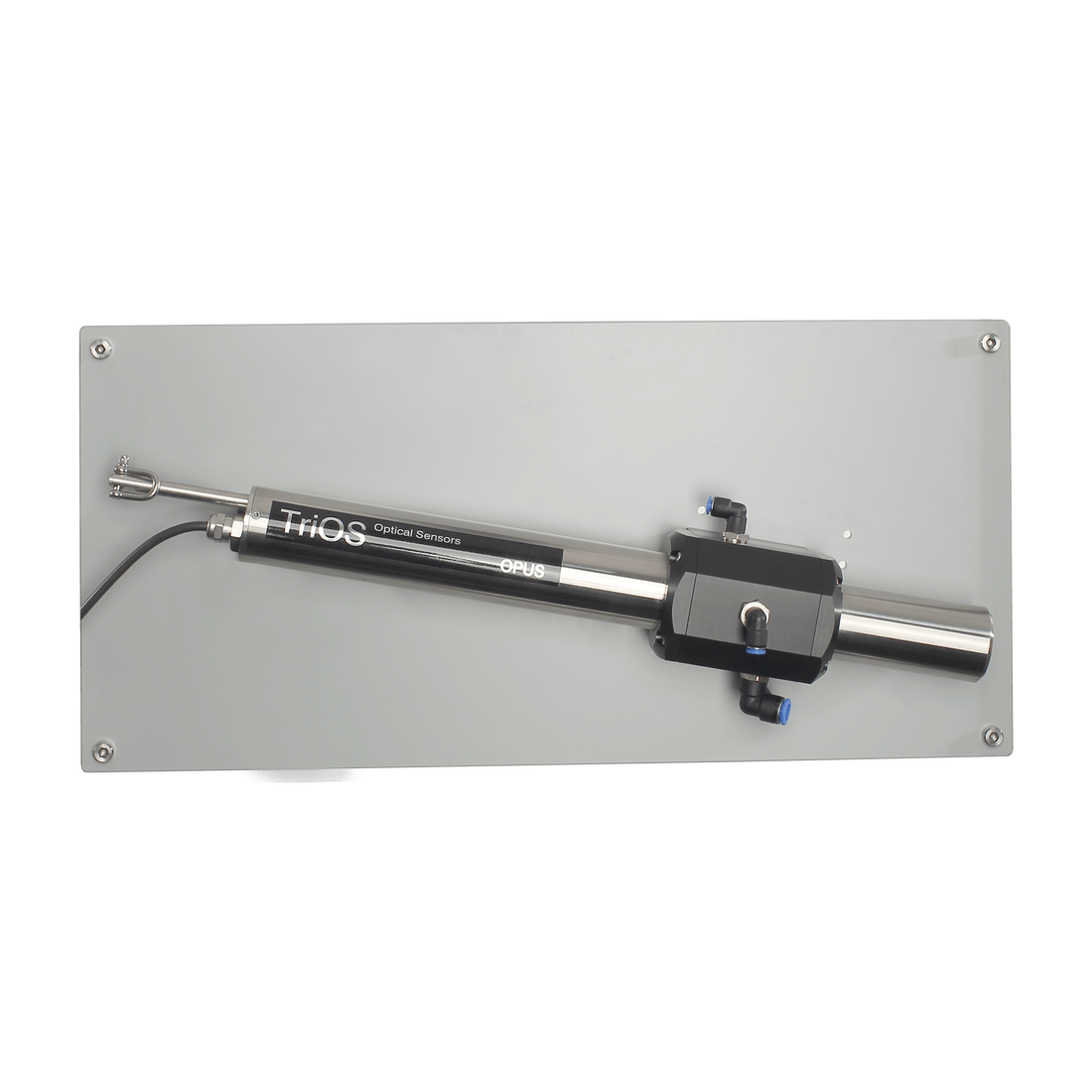OPUS
Description
Versions
Downloads
Description
UV spectral sensor for online measurement of nitrogen and carbon with a resolution of 0.8 nm/pixel.
OPUS is the new generation of spectral probes for the online measurement of nitrogen and carbon compounds. By analyzing a complete spectrum, OPUS is able to provide reliable readings for N-NO3, N-NO2, organic compounds (CODeq, BODeq, DOCeq, TOCeq) and a range of other parameters.
OPUS is equipped with the new TriOS G2 interface, which enables simple and fast sensor configuration using a web browser. Integration into existing process control systems and external data loggers has never been easier.
Using WLAN, a laptop, tablet or smartphone can then simply be used for control without the need to install special application software or an app.
Versions

Downloads
Benefits
- Without sampling and preparation of test samples
- Real-time sensor
- Without reagents
- Optical window with nano coating
- Pre-installed application calibration
Areas of application
- Sewage treatment plants
- Environmental monitoring
- Drinking water monitoring
- Industrial applications
Parameters
- N-NO3 / Nitrate
- N-NO2 / Nitrite
- CODeq
- BODeq
- DOCeq
- TOCeq
- TSSeq
- KHP
- SAC254
- CODeq- SACeq
- BODeq - SACeq
Technical Data
Technical Data
Measurement Ranges
Technical Data
| Light source | Xenon flash lamp | |
| Detector | High-end miniature spectrometer | |
| 256 Channels | ||
| 200 to 360 nm | ||
| 0.8 nm/pixel | ||
| Measurement principle | Attenuation, spectral analysis | |
| Optical path | 0.3 mm, 1 mm, 2 mm, 5 mm, 10 mm, 20 mm, 50 mm | |
| Parameter | Nitrate N-NO3, Nitrite N-NO2, CODeq, BODeq, DOCeq, TOCeq, | |
| TSSeq, KHP, SAC254, COD-SACeq, BOD-SACeq | ||
| Measurement accuracy | see measurement ranges next page | |
| Turbidity compensation | Yes | |
| Data logger | ~ 2 GB | |
| T100 response time | 2 min | |
| Measurement interval | ≥ 1min | |
| Housing material | Stainless steel (1.4571/1.4404) or titanium (3.7035) | |
| Dimensions (L x Ø) | 470 mm x 48 mm (with 10 mm path) | ~ 18.5“ x 1.9“ (with 10 mm path) |
| Weight stainless steel | ~ 3 kg (with 10 mm path) | ~ 6.6 lbs (with 10 mm path) |
| Weight titanium | ~ 2 kg (with 10 mm path) | ~ 4.4 lbs (with 10 mm path) |
| Interface digital | Ethernet (TCP/IP), RS-232 or RS-485 (Modbus RTU) | |
| Power consumption | ≤ 8W | |
| Power supply | 12…24 VDC (± 10 %) | |
| Maintenance effort | ≤ 0.5 h/month (typical) | |
| Calibration/maintenance interval | 24 months | |
| System compatibility | Modbus RTU | |
| Warranty | 1 year (EU: 2 years) | US: 2 years |
| Max. pressure with SubConn | 30 bar | ~ 435 psig |
| Max. pressure with fixed cable | 3 bar | ~ 43.5 psig |
| Max. pressure in FlowCell | 1 bar, 2…4 L/min | ~ 14.5 psig at 0.5 to 1.0 gpm |
| Protection type | IP68 | NEMA 6P |
| Sample temperature | +2…+40 °C | ~ +36 °F to +104 °F |
| Ambient temperature | +2…+40 °C | ~ +36 °F to +104 °F |
| Storage temperature | -20…+80 °C | ~ -4 °F to +176 °F |
| Inflow velocity | 0.1…10 m/s | ~ 0.33 fps to 33 fps |
Measurement Ranges
| Parameter | Measurement principle | Unit | Factor | path length [mm] | ||||||
|---|---|---|---|---|---|---|---|---|---|---|
| 0.3 | 1 | 2 | 5 | 10 | 20 | 50 | ||||
| absorbance | spectral | AU** | – | 0.01…2.2 | 0.01…2.2 | 0.01…2.2 | 0.01…2.2 | 0.01…2.2 | 0.01…2.2 | 0.01…2.2 |
| absorbance | spectral | 1/m | – | 50…7300 | 15…2200 | 7.5…1100 | 3…440 | 1.5…220 | 0.75…110 | 0.3…44 |
| Nitrate N-NO3 | spectral | mg/L | – | 1.0…330 | 0.3…100 | 0.15…50 | 0.06…20 | 0.03…10 | 0.015…5 | 0,006…2 |
| Nitrate NO3 | spectral | mg/L | – | 4.43…1460 | 1.33…440 | 0.67…220 | 0.27…88 | 0.13…44 | 0.067…22 | 0.030…9 |
| Nitrite N-NO2 | spectral | mg/L | – | 1.7…500 | 0.5…150 | 0.25…75 | 0.1…30 | 0.05…15 | 0.025…7.5 | 0.01…3 |
| Nitrite NO2 | spectral | mg/L | – | 5.6…1650 | 1.65…500 | 0.82…250 | 0.33…100 | 0.17…50 | 0.083…25 | 0.033…10 |
| DOCeq | spectral | mg/L | – | 17…3300 | 5.0…1000 | 2.5…500 | 1.0…200 | 0.5…100 | 0.25…50 | 0.1…20 |
| TOCeq | spectral | mg/L | – | 17…3300 | 5.0…1000 | 2.5…500 | 1.0…200 | 0.5…100 | 0.25…50 | 0.1…20 |
| CODeq | spectral | mg/L | – | 100…7300*** | 30…2200*** | 15…1100*** | 6.0…440*** | 3.0…220*** | 1.5…110*** | 0.6…44*** |
| BODeq | spectral | mg/L | – | 100…7300*** | 30…2200*** | 15…1100*** | 6.0…440*** | 3.0…220*** | 1.5…110*** | 0.6…44*** |
| KHP | spectral | mg/L | – | 17…13300 | 5.0…4000 | 2.5…2000 | 1.0…800 | 0.5…400 | 0.25…200 | 0.1…80 |
| SAC254 | Single wavelength | 1/m | – | 50…7300 | 15…2200 | 7.5…1100 | 3.0…440 | 1.5…220 | 0.75…110 | 0.3…44 |
| COD-SACeq**** | Single wavelength | mg/L | 1.46 | 75…10600 | 22…3200 | 11…1600 | 4.4…640 | 2.2…320 | 1.1…160 | 0.44…64 |
| BOD-SACeq***** | Single wavelength | mg/L | 0.48 | 24…3500 | 7.2…1050 | 3.6…525 | 1.44…210 | 0.72…105 | 0.36…52.5 | 0.15…21 |
| TSSeq***** | Single wavelength | mg/L | 2.6 | 130…4300 | 40…1300 | 20…650 | 8.0…260 | 4…130 | 2.0…65 | 0.8…26 |


